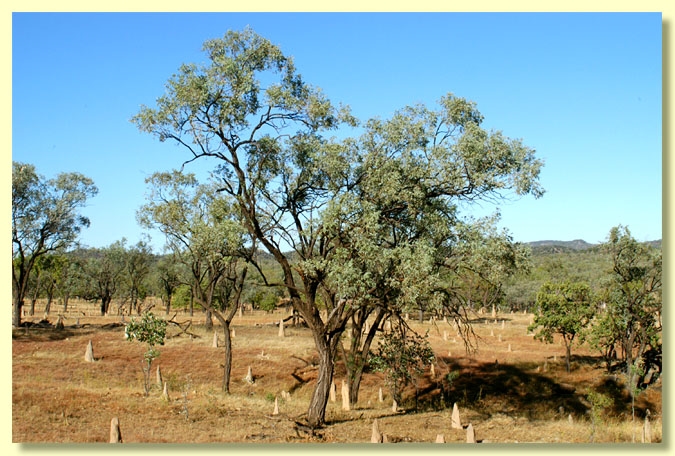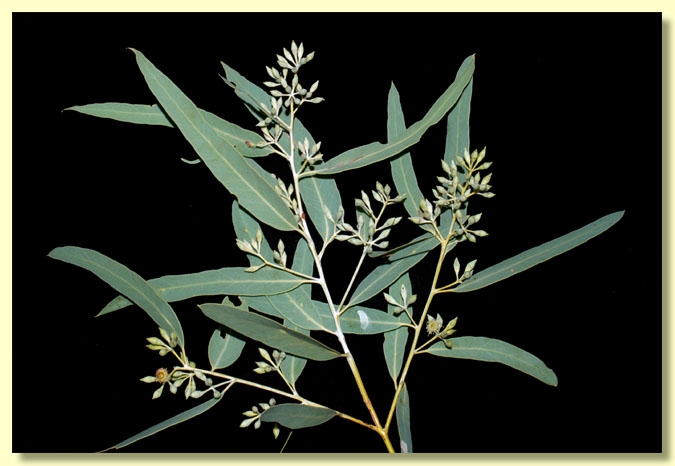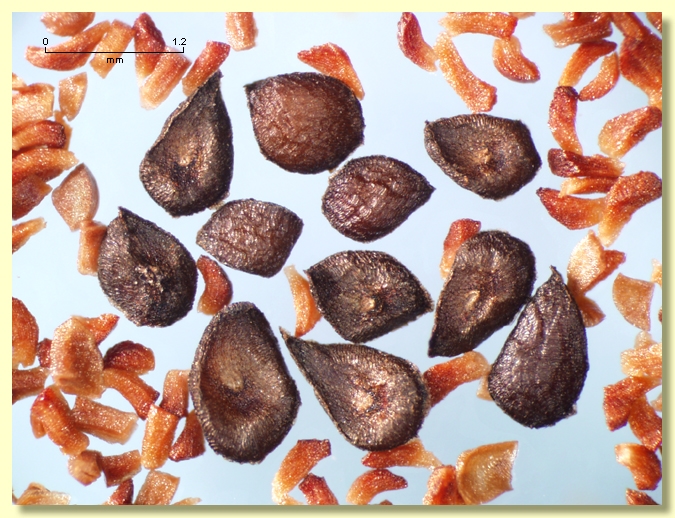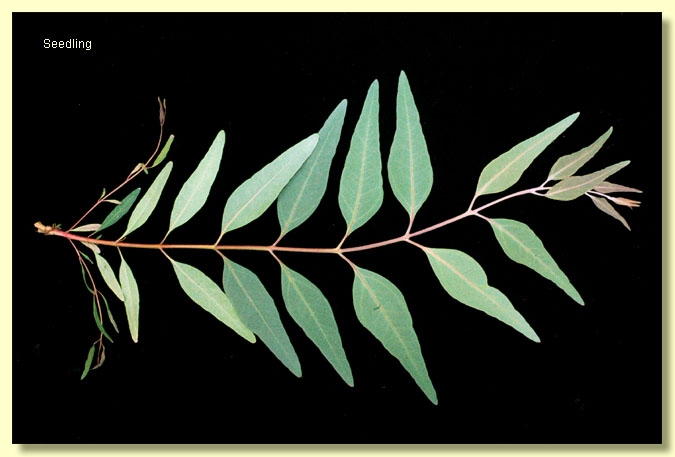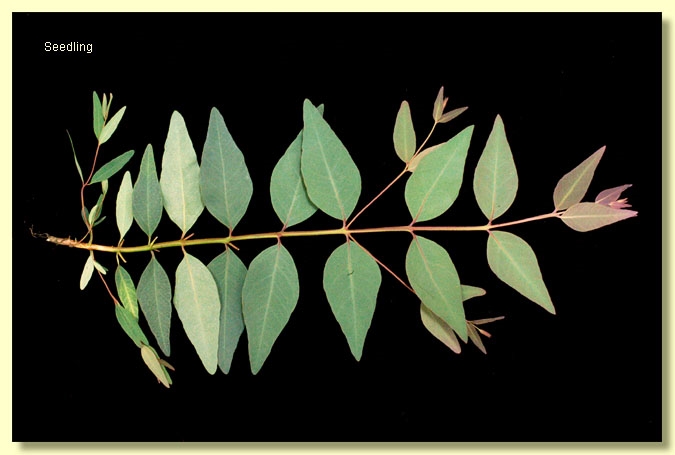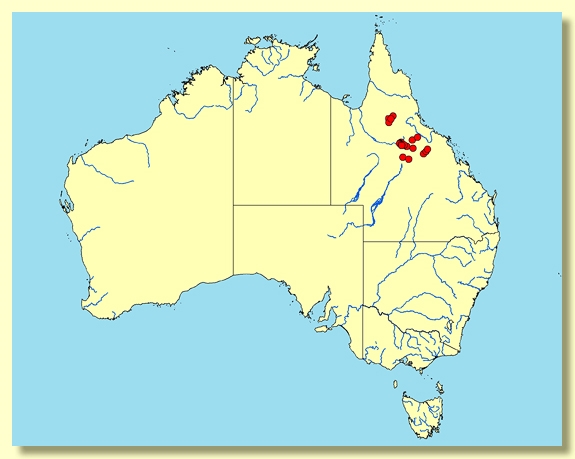Euclid - Online edition
Eucalyptus whitei
Eucalyptus | Symphyomyrtus | Adnataria | Apicales | Siderophloiae | Subglaucae
Eucalyptus whitei Maiden & Blakely, J. & Proc. Roy. Soc. New South Wales 59: 172 (1925).
T: Queensland: Berricania, Sept 1920, J.S.Swanson s.n.; lecto: NSW, fide J.H.Maiden, Crit. Revis. Eucalyptus 7: 401 (1927); isolecto: BRI.
Tree to 15 m tall. Forming a lignotuber.
Ironbark to the small branches, dark grey to black; branchlets usually glaucous but glaucescence fading with age.
Juvenile growth (coppice or field seedlings to 50 cm): stem rounded in cross-section, glaucous; juvenile leaves petiolate, alternate, rarely sub-opposite, ovate to broadly lanceolate, (4.5)6–12 cm long, (1.5)2–4.2 cm wide, base tapering to petiole, glaucous.
Adult leaves alternate, rarely sub-opposite, petiole 0.3–1.5 cm long; blade lanceolate, 6–12 cm long, 1.2–2(2.5) cm wide, base tapering to petiole, concolorous, dull, grey-green to glaucous, side-veins normally at an angle less than 45° to midrib, occasionally at a larger angle, densely to very densely reticulate, intramarginal vein parallel to and just within margin, oil glands sparse intersectional or absent.
Inflorescenceterminal compound, or axillary compound or axillary single umbels below this, peduncles 0.5–1.5 cm long, buds 7 per umbel, pedicels 0.2–0.6 cm long. Mature buds obovoid to pear-shaped, 0.5–0.7 cm long, 0.3–0.4 cm wide, glaucous, scar usually present (first operculum sheds very early in bud development), operculum conical to rounded to beaked, stamens irregularly flexed, anthers cuboid, adnate, slits or pores separate, style long, stigma blunt or pin-head shaped, locules 4, the placentae each with 4 vertical ovule rows. Flowers white.
Fruit on pedicels 0.2–0.7 cm long, cup-shaped to barrel-shaped, glaucous but glaucescence fading with age, 0.4–0.6 cm long, 0.4–0.6 cm wide, disc descending, valves 4, tips near the rim or enclosed or sometimes slightly exserted.
Seeds brown, sometimes very dark and almost black, 1–2 mm long, flattened-ovoid, sometimes pointed at one end, dorsal surface shallowly reticulate, hilum ventral.
Cultivated seedlings (measured at ca node 10):cotyledons oblong to reniform; stems square in cross-section, non-glaucous or faintly glaucous; leaves always petiolate, opposite for 6–11 nodes then alternate, lanceolate or ovate, 5.5–10 cm long, (0.7)1.5–3 cm wide, base tapering, margin entire, apex pointed, only slightly discolorous, dull, grey-green or green.
Flowering has been recorded in January, February, May and June.
An ironbark species endemic to central and northern Queensland from just east of Yalleroi Station south of Jericho, north-west to the Hughenden – Torrens Creek – Mt Hope Station area, with a slightly disjunct population further north in the Newcastle Range – Forsayth area, and also occurring on the Windsor Tableland. Characterised by its ovate to lanceolate glaucous juveniles, its petiolate, lanceolate, glaucous to grey-green adult leaves, the glaucous buds and the small cup-shaped to barrel-shaped fruit. E. whitei is very closely related to E. staigeriana from Cape York. Morphologically there is very little difference between the two. E. staigeriana is noted for its strong smell of lemon from crushed leaves. E. whitei is also closely related to E. melanophloia and intergrades occur between both species in some areas where both overlap. E. melanophloia is easily separated morphologically by normally having opposite, ovate to cordate, sessile leaves in the mature crown. However, a recent study by Holman et al (2011) show that the two species form a cline, especially notable in leaf form, in response to rainfall.
Within its area of occurrence, E. whitei could be confused with E. farinosa. Both species can have petiolate, blue-grey to glaucous adult leaves. E. farinosa differs by having larger ovate to broadly lanceolate adult leaves, larger orbicular juveniles and larger obovoid buds with longitudinal ribs.
Two other closely related species, E. atrata and E. paedoglauca, differ marginally by having slightly larger, broadly lanceolate to ovate juvenile leaves, 3.5–8 cm wide in E. paedoglauca and E. atrata, 2–4.2 cm wide in E. whitei.
Eucalyptus quadricostata, another ironbark from the same general area as E. whitei, differs by having buds and fruit that are square in cross-section.
Eucalyptus cullenii, from areas north of the distribution of E. whitei, differs by having more or less globular buds with a rounded operculum and fruit with a broad, flat disc.
Eucalyptus whitei: after Cyril Tenison White (1890–1950). Cyril White was a grandson of the noted Queensland botanist Frederick Manson Bailey and succeeded an uncle, J.F. Bailey, as Government Botanist of Queensland in 1917, a position he held until his death. He showed a keen interest in botany from an early age and was responsible for many publications during his career. He prepared the 976 line drawings in F.M. Bailey's Comprehensive Catalogue of Queensland Plants (2nd edn) (1913), and wrote extensively on the Queensland flora, in the fields of both taxonomy and economic botany. He was principally responsible for developing the Queensland Herbarium as a public institution, setting up networks of collectors, organising routine mounting of specimens, and insisting on adequate labelling.

